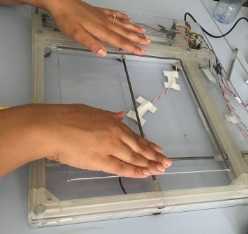F2T
Force Feedback Tablet
Presentation of F2T functionalities
We proposed a haptic surface device based on the principle of force-feedback, named F2T (Force Feedback Tablet) to create the possibility to experience a 2D space environment through touch. The force feedback principle follows the principle of interaction with the user allowing a better comprehension of image contents. The F2T device consists of a small thumbstick mounted on an actuated support. The thumbstick acquires the user’s movement intentions, and the actuated support generates haptic effects by moving the thumbstick under user’s finger.

Fig. 1 Concept of F2T Force-Feedback tablet: a flat thumbstick (center of the tablet) acquires user’s intended movements; the actuated support moves the thumbstick to generate a large variety of haptic effects.
This architecture allows a wide range of haptic and interactive effects to represent the content of an environment.
- Passive feedback, by slowing down or stopping the finger’s movement. This effect makes possible to represent different kind of frictions (fluid friction when the speed reduction is proportional to intended speed, and solid friction when the reduction is constant) to help discriminating areas and textures, and height variations and edges, by accelerating, slowing down or stopping movement according to the slope, to help integrating object’s shape.
Red encodes fluid friction
Blue encodes solid friction
Green encodes height variations and borders.
- Interactive and dynamic effects, such as flows and attractive/repulsive force field, to represent a dynamic and interactive environment (e.g. waterflow) or to assist user’s exploration.
Use of active effects: flows.
Another active effect: the rails. The finger is deflected towards a given direction
- Guidance mode, where the F2T guides user’s finger on a predefined path without considering user’s intention, allowing a guided exploration of the surface content. . The efficiency and resulting perception of space using F2T’s haptic effects are outlined through tests on spatial comprehension.